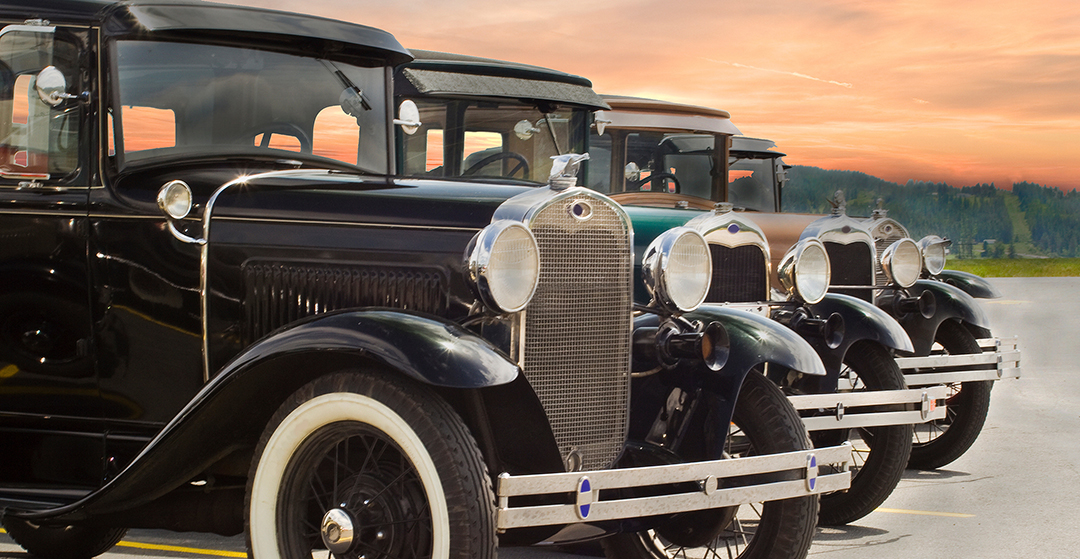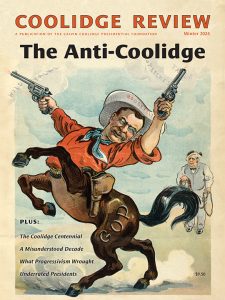By John H. Cochrane

This article appears in the Winter 2024 issue of the Coolidge Review.
The 1920s were the single most consequential decade for the lives of everyday Americans. This is when the contours of modern life emerged.
Technological innovations diffuse by an S shape. Something is invented; it trundles along for a couple of decades; then it becomes a toy of the rich, perhaps; then it spreads quickly through the population; finally, we spend another couple of decades making it better. The S-curve applies to airplanes, cars, or practically any other technology you can think of. The middle of the S-curves of many important technologies coincided in the 1920s. Growth wasn’t about the accumulation of stuff; it was about changing the way everyday people lived their lives.
At the beginning of the 1920s, about 30 percent of American homes had electricity. By the end of the decade, nearly 70 percent had been electrified. Famously, the Vermont home of Calvin Coolidge’s father had no electricity in 1923 when word arrived that President Warren Harding had died. That’s why Coolidge took the oath of office by kerosene light.
Electricity improved during that time, too, as alternating current, or AC, became standardized. With that came electric lights instead of kerosene lamps, and electric appliances such as the iron, the toaster, the washing machine, and the vacuum cleaner. Electricity revolutionized home life, removing much of the drudgery.
Electricity changed the economy as well. In 1914, only 30 percent of manufacturing was electrified; by 1929, that number had reached 70 percent.
How did electricity get to homes and factories? Was there a big federal program to build the massive infrastructure of power stations and wires needed? No, private utilities built it.
In 1920, 20 percent of people had automobiles; by 1929, 60 percent of families owned cars. There were 9 vehicles for every 10 households. The automobile revolution happened in one decade.
Cars weren’t just a convenience; they brought a massive change in how people lived their lives. Previously, people needed to live right near a soot-emitting factory where they worked. Now they could move somewhere where they could have a more pleasant life. The car helped to make that possible.
The automobile also eased rural isolation. By 1929, most farmers had cars to get them to town. The car connected them.
The transportation revolution didn’t occur because the federal government offered tax breaks and subsidies. There was no federal spending bill to build the network of gas stations motorists needed. No, the filling stations came in on their own when people figured out that they could make money operating them.
The 1920s saw a revolution in communications as well. The telephone, the phonograph, radios, and movies became ubiquitous parts of daily life. Radio went from essentially zero at the beginning of the decade to a pervasive feature of American life. Broadcast networks were born in the 1920s, creating mass media.
How did these changes happen? As usual, pretty much everything occurred despite the government.
Indoor plumbing, water, sewer, and gas all were practically absent in 1920 and close to universal in 1930. That meant the end of the outhouse, of fetching water from a pump, of cooking over a coal stove.
Infant mortality plunged. Doctors started to know what they were doing.

The 1920s also brought innovations in finance. Consumer credit was invented. In 1926, 75 percent of new vehicle purchases were financed. Financing spread to household appliances, helping people to afford these wonderful new things.
Shopping used to mean going to the general store and negotiating the price of your bread. Chain stores and fixed prices emerged in the 1920s. Sears moved from catalogues to stores, and of course you could go to the store in your car now. National chains had 7,500 outlets in 1920 and 30,000 in 1930—15,000 of those by A&P alone.
Government Stays Out of the Way
Average earnings rose 30 percent in a decade. Gross domestic product (GDP) rose by a third, but that figure understates the scope of the transformation. It’s not that people now had three kerosene lamps instead of two, or his and hers outhouses instead of a single outhouse. GDP vastly understates gains in human welfare.
This great economic and lifestyle revolution for Americans of modest means happened with basically no guidance from the federal government. The government largely stayed out of the way. And the government did not try to regulate improvement in the name of “equity.” Is it terrible that rich people got to buy a Model T Ford in 1924 and poorer people waited until 1927 to buy one at half the price? Would we look back and wish the government had slowed it all down in the name of equity?
All the growth and improvements occurred against a backdrop of a pandemic, inflation, a large federal debt, revolution in Russia, and culture wars at home, with a serious question whether our country would go the same way.
In this context, President Coolidge and Treasury Secretary Andrew Mellon engineered the first great supply-side tax cut, dropping the top rate from 77 percent in 1918 to 25 percent.
Yet tax revenue rose, including from the rich people whose rates dropped most dramatically. A lot of that revenue came from compliance—getting rid of tax loopholes. When you cut the tax rate and eliminate loopholes, you often get more tax revenue.
Deficits disappeared. Thrifty Calvin Coolidge made sure of that. Congress had plenty of ideas for spending, but each year in the 1920s, the federal government generated a surplus. Coolidge and Mellon and Congress reduced the federal debt, and the economy boomed.
So much for stimulus.
The Great Refrainer
What did Coolidge do? He constrained mischief on spending, fought for tax cuts, and made sure the government stayed out of the way. He appointed commissioners to the Federal Trade Commission and the Interstate Commerce Commission who did little to restrict the activities of businesses under their jurisdiction. The regulatory state under Coolidge was thin to the point of invisibility. He vetoed farm subsidies—twice. Lots of bad ideas came up, and Coolidge’s job was to say no.
As others have demonstrated, Coolidge had some progressive policy preferences. But his view was that those were state and local matters with which the federal government was not allowed to interfere. He did what he did largely out of respect for institutions.
And that is a wonderful thing. If we would only respect the institutions, we wouldn’t need to try to appoint somebody who shares all our ideas. Let’s fix the institutions.
The humorist Will Rogers said of Coolidge, “He didn’t do nothing, but that’s what we wanted done.” It’s a great line, but it’s utterly wrong. Coolidge did hard work to beat back bureaucratic expansion, to cut tax rates, to restrain spending, to say no to endless bad ideas, and to do the institutional reform of putting in a budget process. He did a lot!
We often hear about “transformative leaders.” But too often that means leaders who expand the size and scope of the federal government. What about leaders who stay out of the way, do their bit to improve the machinery of government, work valiantly to fight the weeds, and preserve and strengthen the institutions of American government? We should celebrate them as our greatest leaders—the fixers, the quiet reformers, the minders of the store, the preservers of our institutions.
Stop looking for transformative leaders. We don’t need another great government crusade. Once again, we need a return to normalcy.
John H. Cochrane, an economist specializing in financial economics and macroeconomics, is the Rose-Marie and Jack Anderson Senior Fellow at the Hoover Institution. Cochrane is also an adjunct scholar of the CATO Institute. He writes the Grumpy Economist blog.